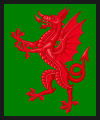
Back Ffiwsilwyr Brenhinol Cymreig CY Royal Welch Fusiliers German Royal Welch Fusiliers French Королевские уэльские фузилёры Russian
| 23rd Regiment of Foot Welch Regiment of Fusiliers Royal Welch Regiment of Fusiliers Royal Welch Fusiliers | |
|---|---|
 Cap badge | |
| Active | 16 March 1689 – 28 February 2006 |
| Country | |
| Branch | |
| Type | Infantry |
| Role | Line infantry |
| Size | 1–2 Regular battalions 4–12 Volunteer and Territorial battalions |
| Garrison/HQ | Hightown Barracks, Wrexham |
| Nickname(s) | The Nanny Goats[1] The Royal Goats[1] |
| Motto(s) | Ich Dien |
| Anniversaries | St. David's Day (1 March) |
| Engagements | Williamite War in Ireland Nine Years' War War of the Spanish Succession War of the Austrian Succession Seven Years' War American War of Independence French Revolutionary Wars Napoleonic Wars Crimean War Second China War Indian Mutiny Third Anglo-Burmese War Second Boer War First World War Second World War The Troubles Yugoslav Wars |
| Commanders | |
| Ceremonial chief | The King |
| Colonel of the Regiment | Major-General Brian Plummer |
| Insignia | |
| Tactical Recognition Flash |  |
| Hackle | White |
The Royal Welch Fusiliers (Welsh: Ffiwsilwyr Brenhinol Cymreig) was a line infantry regiment of the British Army, and part of the Prince of Wales's Division, that was founded in 1689; shortly after the Glorious Revolution. In 1702, it was designated a fusilier regiment and became the Welch Regiment of Fusiliers; the prefix "Royal" was added in 1713, then confirmed in 1714 when George I named it the Prince of Wales's Own Royal Regiment of Welsh Fusiliers. In 1751, after reforms that standardised the naming and numbering of regiments, it became the 23rd Regiment of Foot (Royal Welsh Fuzileers). In 1881, the final title of the regiment was adopted.
It retained the archaic spelling of Welch, instead of Welsh, and Fuzileers for Fusiliers; these were engraved on swords carried by regimental officers during the Napoleonic Wars.[2] After the 1881 Childers Reforms, normal spelling was used officially, but "Welch" continued to be used informally until restored in 1920 by Army Order No.56.
It should not be confused with the Welch Regiment, a different unit (formed in 1881 from the 41st and 69th) which recruited in South and West, rather than North Wales, and became part of the Royal Regiment of Wales or RRW in 1969.[3]
One of the few regiments to retain its original title, in March 2006 the Royal Welch Fusiliers was amalgamated with the RRW and became 1st Battalion, Royal Welsh, with RRW as the 2nd Battalion.
- ^ a b Burnham, Robert; McGuigan, Ron (2010). The British Army against Napoleon. Barnsley, South Yorkshire: Frontline Books. p. 125. ISBN 978-1-84832-562-3.
- ^ "Napoleonic Welch Fuzileers Sword". Antique Swords. Retrieved 8 April 2018.
- ^ "Royal Welch Fusiliers Museum safeguards valuable First World War memories". Welsh Government. 15 April 2014. Archived from the original on 17 April 2014. Retrieved 23 May 2014.